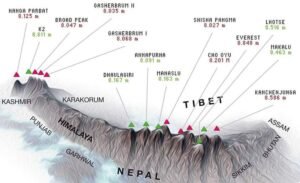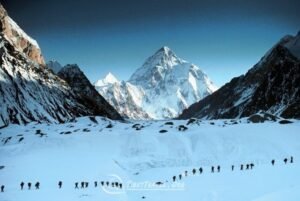Introduction
The summit of an eight-thousander (a mountain with a height over 8,000 metres or 26,247 feet) is the ultimate test of endurance, skill and mental stamina for mountaineers. Shishapangma is one of the world’s 14 eight-thousanders.This mountain is standing at 8,027 meters (26,335 feet), is the lowest of the 14 eight-thousanders and often considered one of the easier ones in terms of technical challenge. But it is still by far the least climbed of the bunch, mostly because of its relative isolation and the political mess surrounding access.
For many people who want come out the crowded trails, this relatively unknown climb delivers in the stunning yet hidden plateau of the Tibetan Himalayas. In this post, we will look at why Shishapangma is so easy to climb but yet remains one of the least climbed 8-thousanders as well as what any aspiring climbers need to consider when they are about to set an expedition in a beautiful but underrated mountain.
01. The uniqueness of shishapangma in the mountaineering scene
This creation of nature lies wholly within Tibet, a region of China, which has made many claims about its status as the 14th peak in excess of 8000 meter. Overall, it is the highest mountain in the Jugal Himal and somewhat odd in that it is not part of a substantial mountain range. Its easy climb, it proximity to Lhasa (5 hour by car) and the fact that it is much easier compared to the major 14 peaks such a K2 or Annapurna, which are famous for their high death rates and extreme technical difficulties generally earn Shishapangma as good first choice mountain.
But still, comparing with mountains like Everest or K2, Shishapangma has obviously been summited far less times. A great deal of that has to do with its situated in a politically charged quarter. Though how to access the mountain is another story.Special permits and coordination with Chinese authorities are required, making it difficult for expeditions to land in Tibet. Besides, with many of the more distinguished peaks located close by, it is sometimes oh-so-gently shoved to the back of the queue by climbers looking to bag one of the world’s premier 8000ers.
02. Why Climb Shishapangma?
Ease of Climbing: It is often classified as an ‘entry level’ eight-thousander, with its 1000+ foot high standard route being almost purely a snow and glacier climb without any of the hard rock or ice technical problems faced by peaks like K2.
Few Crowds: You’ll be far more alone on these slopes than you would in the crowded highways of Everest, so this is a good choice for those looking for a more personal, isolated trip.
Quieter Adventure: Namach peak, the Astana forecast 8000m high-point and mountain that is least often visited by climbers on all fourteen peaks.
03. A Brief History of Shishapangma Climbing
This himalyan beauty was first climbed on May 2, 1964 by a Chinese expedition led by Xu Jing, the last of the eight-thousanders to be summited. In contrast to well-known peaks such as Everest and K2, has only a short history of attempts and climbs by outsiders due to its location entirely within Tibet (until the 1960s).

The mountain has been peaked over the decades by many legendary climbers, but it still attracts fewer expeditions than its more famous cousins. Nevertheless, it has aquired respect as an appropriate challenge because of the challenging high-altitude climbing conditions, the well known weather systems and the objective risks of avalanches and crevasses on its possible routes.

Northwest Ridge (Normal Route) – From the North side of the mountain, glacier travel, ice climbing and snow climbing. Although less technical than the other routes to climb Mont Blanc, climbers still have to deal with crevasses, ice fields and high altitude winds after they ascend the three person gondola above Chamonix.
Southwest Face – A much more technical and serious route, providing a more difficult and steeper climb. This face is well suited for only highly experienced mountaineers, as it incorporates mixed terrain, (rock, ice and snow).
South Face – The South Face is as beautiful as it is difficult, being so hard and steep a route that almost nobody climbs it due to its avalanching risks. Famous climbers have died on this route.
An Opinion of the Northwest Ridge – The simplicity of the Northwest Ridge appeals to me as a high-altitude mountaineer. The Cat 1 may not meet the extreme, high-altitude technical nature of everest’s South Col or Annapurna North face but attitude and styles still play a major factor here. THOUGHTS: For more experienced climbers with several high-altitude peaks under their belt this might be a better option.
05. Challenges of Shishapangma Space between
Although it is frequently called the “easiest” 8000er, this should certainly not lull climbers into complacency. Simply being at an altitude of around 8,850 meters (29,000 feet) guarantees physiological hardship: the threat of altitude sickness and the stress on a body operating in what climbers call “the death zone,” above 8,000 meters where oxygen levels are critically low. Even in professional mountaineers, it is necessary to acclimatize adequately as this will prevent conditions such as cerebral and pulmonary edema which can be fatal.
The physical and even mental endurance it would take to climb at such high elevations is unbelievable. The isolation, the cold and wet tents, long days of climbing day after day in challenging weather can get to even the most seasoned mountaineer.
Physical Challenges: With Acclimatization Just like any eight-thousander, climbers need to acclimate, which includes multiple rotations between camp 1 — and possibly even base camp — and higher camps before a summit push.
Amidst the snow: The weather there can be hectic, freezing cold and strong wind are not uncommon, especially on the longest ridge of a summit.
A factor in fatigue: High-altitude expeditions often require long climbing days with minimal rest, and the body lies rested less frequently than it would at sea level.
Mental Challenges
Isolation: Chances are you’ll be climbing solo or with a very small team, as it doesn’t see the crowds of Everest and K2.
Unpredictable Weather: Common storms and extreme winds make summit attempts less likely or climbers turn around, patience and skill are required if weather becomes too severe.
Risk Management: with less infrastructure and fewer fixed ropes (including no support from Sherpa for fixing rope, carrying load etc) than Everest, climbers have to be more self reliant- riskier but much safer if one is confident that oneself can make right decision as well as being strong.




06. Preparing for Shishapangma
As with all eight-thousanders, the key for this expedition is in the preparation. While it has become known as a less technical climb, ascending an 8,000-meter peak is still a major endeavor. Climbers must be exceptionally fit, with strong glacier and high-altitude climbing experience as well, and willing to spend weeks on the mountain. Our in depth guidline regrading the preparation is listed for reading.
Physical Preparation
Cardiovascular Endurance: The long days of extended activity at altitude necessitate having excellent aerobic fitness Some examples are running, cycling or even going up and down stairs to build your endurance.
Building Strength: You will need strong legs and core muscles to lift and move heavy things and climb steep snowfields or ice. Perform exercises such as squats, lunges and deadlifts to develop this strength.
Acclimatization: This is pre-acclimatization that we all need for an eight-thousander. Ideally climbers should pre-acclimatise before the expedition, by climbing smaller peaks or altitude simulation training.
If you really want be prepared for the expedition follow our in depth guid to build your physical endurance
Technical Skills
Snow and Ice Climbing: The standard route itself is non-technical, but it does include glacier travel, crevasse crossing and simple ice climbing. To this end, we will begin by reviewing some of these techniques that are fundamental.
Crevasse Rescue: the route involves crevassed glaciers so be sure to know how to do a crevasse rescue in case you take a fall.
Mental Preparation
Psychological Training: Make sure you are training your mind to be prepared for the isolation, cold and long hours of adversity just like a physical routine. When climbers can see the goal, and know that the unexpected parts of journey were only setbacks (e.g. bad weather), then they are more likely to hang on.
07. Why Shishapangma is the least climbed
Eight-Thousander?
Why Shishapangma is the least sought-eight: Accompanied by several factors
Located: Its situation in Tibet makes logistics a bit difficult due to the political status and also you need special permits from Chinese government. Tibet has also been closed or inaccessible in parts at various times which has reduced the number of expeditions
Obscurity: It is not as globally famous as Everest, K2 or Annapurna. Most climbing celebrities or those seeking recognition by sponsors choose to climb the more popular mountains. whilst other climbers would rather pursue more the famous peaks of the region (Cho Oyu, Everest etc. and simply pass on climbing Shishapangma.
This mountain being the 14th highest peak across the world, one might think its nose a cake walk compared to Everest but in contrast unlike Everest where you can get fix ropes and summit kits all around the trail as well huge number of cunning expedition team ranks its top, on Shishapangma commercialization is somewhat nonobserved. There are fewer guiding companies running trips here so climbers must be more self sufficient.
08. My Shishapangma Story
Indeed, Shishapangma is sometimes branded as the “simplest” of all eight-thousanders but in every case there is nothing easy in high altitude mountaineering. The altitude, isolation and weather challenges are the same on Shishapangma as any of the other 13 mountains in excess of 8,000 metres.
It has the distinction of being a high-altitude mountain that climbers can ascend in relative peace, far from some of the more orderly and commercialized 8000m peaks.

As I progressed through rep 30, I imagine as a seasoned mountaineer too the inner dialog still and quieted. It is a mountain that demands focus, organization and understanding for she can be a fickle high-altitude environment to deal with.
Conclusion
This mountain is the 14th highest and least climbed eight-thousander, but It still provides adventurers with a grueling experience in high altitudes. While relatively accessible and set within the stunning isolation and vistas of the Tibetan landscape, this is a very serious climb that will appeal to experienced mountaineers. Though not boasting the fame of Everest or K2, Shishapangma is one of mountaineering’s hidden treasures and should be on every climbers to-do list.
Which is one of the easier eight-thousanders, but still offers a great adventure within non-technical terrain for those seeking to summit an 8000 meter peak. When it comes down to it, no climb at this altitude is easy so prepare well and treat the mountain with respect and patience — you will bag it if Mother Nature allows. Happy climbing!




